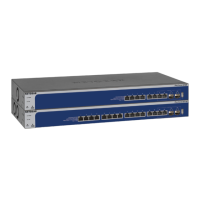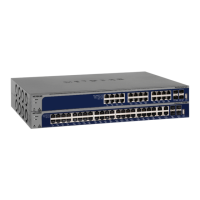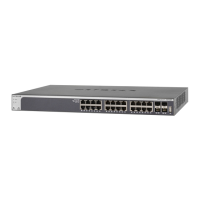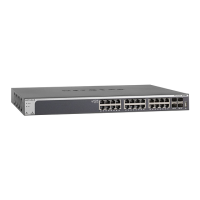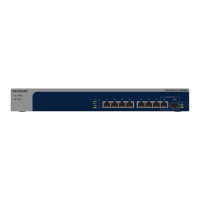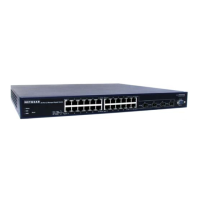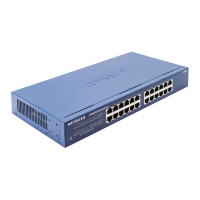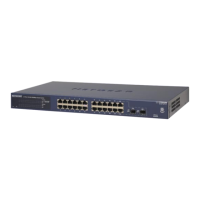
Do you have a question about the NETGEAR XS708T and is the answer not in the manual?
| Switch type | Managed |
|---|---|
| Switch layer | L2+/L3 |
| Quality of Service (QoS) support | Yes |
| USB 2.0 ports quantity | 1 |
| SFP+ module slots quantity | 2 |
| Installed SFP modules quantity | - |
| Basic switching RJ-45 Ethernet ports type | 10G Ethernet (100/1000/10000) |
| Basic switching RJ-45 Ethernet ports quantity | 8 |
| Certification | CE, FCC Cl. A, VCCI Cl. A, Cl. A EN 55022 (CISPR 22), Cl. A C-Tick, EN 55024, CCC |
| Product color | Black |
| LED indicators | Activity, Link, Power |
| Number of fans | 1 fan(s) |
| Number of VLANs | 256 |
| Networking standards | IEEE 802.1D, IEEE 802.1Q, IEEE 802.1ab, IEEE 802.1p, IEEE 802.1s, IEEE 802.1w, IEEE 802.1x, IEEE 802.3, IEEE 802.3ad, IEEE 802.3ae, IEEE 802.3an, IEEE 802.3az, IEEE 802.3u, IEEE 802.3x, IEEE 802.3z |
| Virtual LAN features | Private VLAN, Protocol-based VLAN |
| Cable types supported | Cat5e, Cat6, Cat6a, Cat7 |
| Copper ethernet cabling technology | 10GBASE-T |
| Noise level | 29.1 dB |
| Flash memory | 256 MB |
| Internal memory | 512 MB |
| Processor frequency | 600 MHz |
| Mean time between failures (MTBF) | 276832 h |
| Jumbo frames | 9000 |
| Latency (10 Gbps) | 3.012 µs |
| MAC address table | 16000 entries |
| Packet buffer memory | 2 MB |
| Number of static routes | 32 |
| DHCP features | DHCP server, DHCP client |
| Security algorithms | 802.1x RADIUS |
| Access Control List (ACL) rules | 100 |
| AC input voltage | 100 - 240 V |
| AC input frequency | 50 - 60 Hz |
| Power consumption (max) | 96 W |
| Operating altitude | 0 - 3000 m |
| Operating temperature (T-T) | 0 - 50 °C |
| Operating relative humidity (H-H) | 0 - 90 % |
| Cables included | AC |
| Depth | 204 mm |
|---|---|
| Width | 440 mm |
| Height | 43 mm |
| Weight | 2980 g |
Provides an overview of the switch management interface and how to access it.
Explains methods to change the switch's default IP address for remote management.
Details on finding the switch's IP address when using a DHCP server.
Instructions on how to access the switch's web-based management interface.
Describes how to apply settings simultaneously to multiple ports or LAGs.
Display switch status and configure basic information like IP, clock, and DNS settings.
Configure network information for the management interface.
Configure IPv6 network interface parameters.
Configure system time settings using SNTP or manually.
Configure SNMP settings for SNMPv1/v2 and SNMPv3.
View, configure, and monitor the physical port information and settings.
Add virtual LAN support to divide the network into logical segments.
Prioritize voice traffic over data traffic using classification mechanisms.
Provides a tree topology for bridges, eliminating loops and providing one path.
Manage multicast IP traffic destined to host groups identified by class D addresses.
Configure and display IP routing data.
Configure IPv6 network interface parameters.
Configure switch software to support VLAN routing and inter-VLAN communication.
Associate Layer 2 MAC addresses with Layer 3 IPv4 addresses using dynamic or manual ARP.
Configure queueing aspects and Class of Service (CoS) settings.
Classify traffic into streams and provide QoS treatment using DiffServ.
Filter and process packets based on defined criteria using DiffServ.
Associate a collection of classes with one or more QoS policy statements.
Configure login password, RADIUS, TACACS+, authentication lists, and SCC utility.
Provides a centralized user management system using TACACS+ protocol.
Enable and configure port access control using 802.1X.
Configure MAC filters, storm control, port security, protected ports, and private VLANs.
Configure switch ports that cannot communicate with each other but can access another network.
View number and type of traffic transmitted and received on the switch and its ports.
Manage and view system messages for events, faults, and configuration changes.
Select network traffic for analysis by a network analyzer on specific ports.
Reboot the switch to restart its operation.
Reset the system configuration to factory default values, losing all changes.
Export configuration and log files to a TFTP server or HTTP session.
Download system files from a remote system to the switch via TFTP or HTTP.
Tools for diagnosing network issues, including ping, traceroute, and memory dumps.
Example configuration scenarios for VLAN usage and traffic handling.
Example configuration for creating and applying ACLs for traffic control and security.
Example configuration for classifying traffic and providing QoS treatment using DiffServ.
Example configuration for enabling 802.1X-based port security.
Example configuration for creating MSTP instances for multiple spanning trees.
Lists the default IP address, subnet mask, gateway, and other initial configurations.
Details the default settings for various switch features like STP, LLDP, DHCP Snooping.
Describes default settings for port speed, duplex, flow control, and other port features.
Lists default settings for security features like 802.1X, ACLs, and password control.
